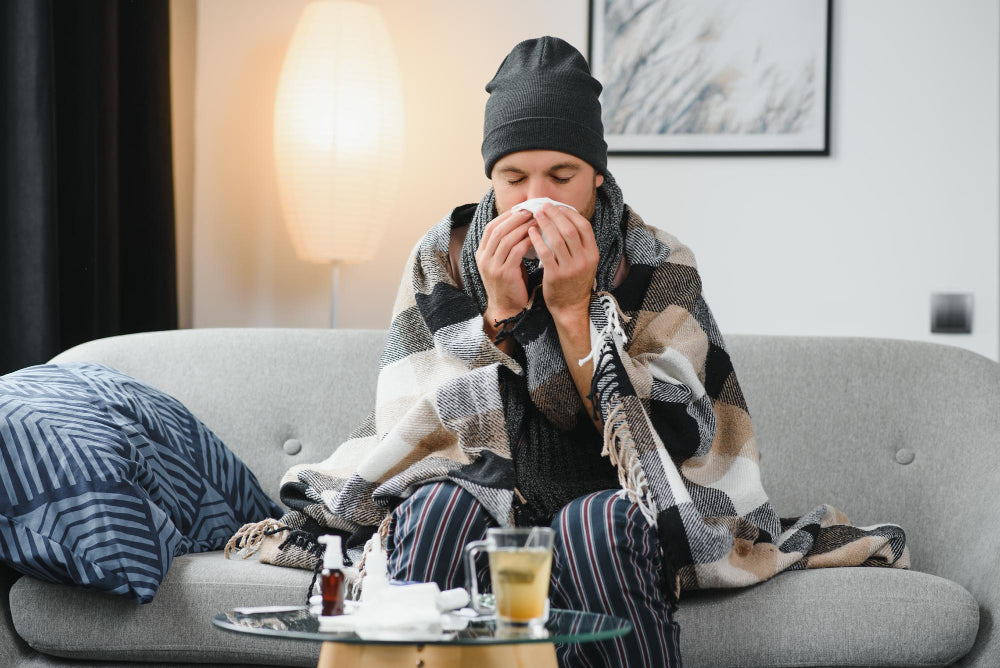Ice baths have long been a topic of debate in wellness and sports communities. While some swear by their benefits, others caution against their potential dangers. But can ice baths make you sick? This article will explore the facts, debunk myths, and provide comprehensive insights into the relationship between cold exposure and illness.
Introduction
So you may have heard that jumping into ice water or an ice bath can make you sick. Alternatively, maybe you have listened to one of the countless old tales that getting cold and wet will make you sick. But what’s the real story behind cold exposure and getting sick, especially regarding ice baths?
So, if you’d like to get the real facts and dispel the myths, keep reading. This article will discuss whether a cold shower or ice bath can really make you sick and answer all the questions regarding illness!
Let’s get started!
Can You Get Sick From Being Wet and Cold?
It's a common belief that exposure to cold and wet conditions can make you sick. However, it's crucial to understand that viruses, not the weather, cause illnesses like the cold and flu. The most common cause of colds is Rhinoviruses, which are transmitted through contact with infected people or surfaces, not through exposure to the cold.
Surprisingly, some evidence suggests that certain forms of cold exposure could actually supercharge your immune system. A study in the Netherlands shows that by taking cold showers, you are 29% less likely to call in sick for work than people who take warm showers! So, the results suggest that cold exposure may strengthen the immune system instead of weakening it.
However, sustained cold exposure is not without risk. After some time in cold water, hypothermia and frostbite can take hold. People with certain health conditions should also ask a doctor before initiating any cold therapy program.
Practical Advice for Using Ice Baths During Illness
Now that we have grasped cold exposure and its effects, shall we look at the recommendations in terms of practical advice? But what if you are starting to feel unwell? Should you just continue with an ice bath? What do you need to know to make the right choice?
Ice Baths and Minor Illnesses
If you have minor ailments (like a fever-free cold), taking an ice bath may help. Cold water reduces inflammation, helps with muscle aches and fatigue, and provides an energy boost.
If you ever feel like your brain’s getting foggy and stuff. Also, the endorphin boost associated with cold exposure can help lift your mood and make you feel better about yourself — always helpful when things aren’t going well. Remember, listen to your body and stop if anything feels wrong.
Avoiding Ice Baths with Fever
Ice baths are not good when you have a fever. Even though it feels nice to cool off, the cold water initiates a natural re-warming mechanism in your body, which can elevate your inner temperature even more dreadfully than before you kicked back.
It causes more stress to your body, which is fighting an infection already. Instead, take your doctor’s advice on how to control fever. While you are getting better and your fever has gone away, you may start to feel more like yourself. Now would be a good time to restart cold therapies into your routine.
How Cold Exposure Affects Immunity
Cold exposure can activate the immune system, such as exposing yourself to ice baths or cold showers. The body reacts to the cold by making more of some types of white blood cells, which are vital in fighting infections.
However, the relationship between cold and immunity is complicated. Exposure can either boost or blight immune function, and the effects can vary depending on factors such as how long a person was out in the cold and how intense the conditions were.
What Is the Cold Shock Response?
Hitting the cold water immediately causes your heart rate and blood pressure to increase, which is referred to as the cold shock response. Your breathing will also become rapid. If you inhale involuntarily while your head is in the water, this can be very dangerous. The initial shock makes the heart have to work harder, which can then result in complications.
By the way, exposure to cold water for extended periods is much more likely to cause hypothermia than simply standing in cold air. As your body strains to defend precious organs, blood flow is rerouted from your limbs, affecting strength and coordination. This can make it hard to move or think properly, further increasing the danger of accidents.
What Are Some Safe Practices for Cold Baths in Colder Months?
You can continue your cold therapy routine in the colder months, but you need to make sure that their practices have little variations depending on the weather.
Following an ice bath, warm up slowly to avoid hypothermia. Avoid the outdoors and wear appropriate attire until your body temperature has decreased.
Safety Tips
- Start slow: If you’re new to cold therapy, start with shorter sessions and slowly build on your session times as you acclimate.
- Do not go alone: Always have someone accompany you to take an ice bath. It's especially important if you’re doing it for the first time or don't have enough experience.
- Monitor your health: If you're shivering uncontrollably, feeling numb or weak, or having any signs of dizziness, that should be a sign to call it quits and get out.
- Pre warm-up: Do light exercises for a few minutes beforehand to raise your body temperature slightly.
Conclusion
Cold weather doesn’t make you sick; it’s knowing how to use cold therapy correctly and safely that really matters. While ice baths can be anti-inflammatory and performance-enhancing, they also come with dangers like hypothermia and cold shock. As always, consult a healthcare professional before beginning any new dietary or exercise routine and review safety instructions!
FAQs
Can ice baths make you sick?
Ice baths can potentially make you sick if not done correctly, especially if you are already ill or have certain health conditions. It's crucial to follow safety guidelines and consult with a healthcare provider.
How long should you stay in an ice bath?
Beginners should start with shorter sessions, around 5-10 minutes, and gradually increase the time as they acclimate. Always listen to your body and exit the bath if you feel uncomfortable.
Are ice baths safe for everyone?
No, ice baths are not safe for everyone. People with certain health conditions, such as cardiovascular issues or cold intolerance, should avoid ice baths and consult with a healthcare provider before trying cold therapy.
What are the benefits of ice baths?
Ice baths can reduce inflammation, relieve muscle soreness, and boost recovery after intense exercise. They may also enhance mood and energy levels through the release of endorphins.
Can cold showers also boost immunity?
Yes, cold showers can also stimulate the immune system by increasing white blood cell production and improving circulation, potentially reducing the frequency of common illnesses.
What is the best time to take an ice bath?
The best time to take an ice bath is usually after a workout to aid in muscle recovery. However, it's essential to ensure your body is not overly fatigued and that you follow proper safety practices.




Leave a comment
This site is protected by hCaptcha and the hCaptcha Privacy Policy and Terms of Service apply.